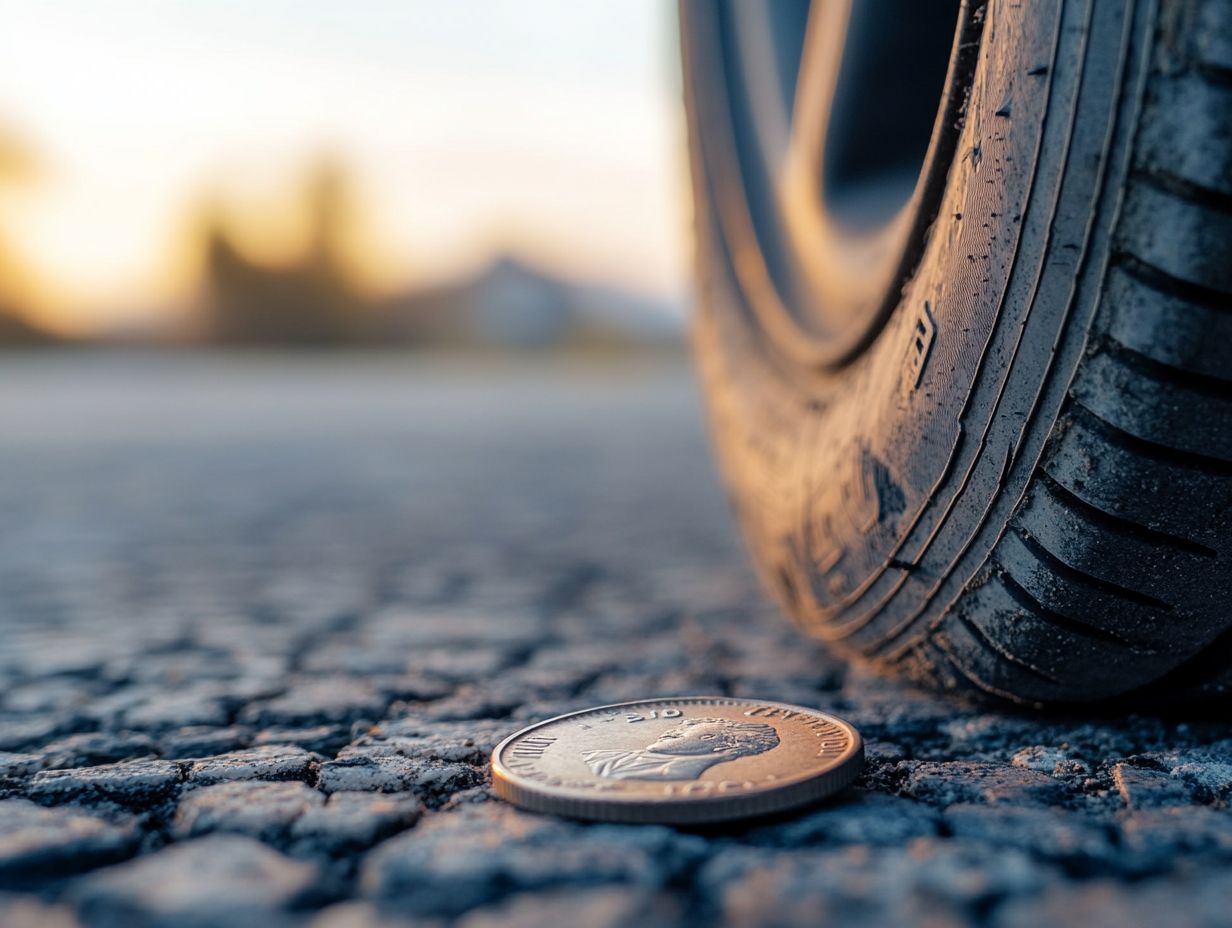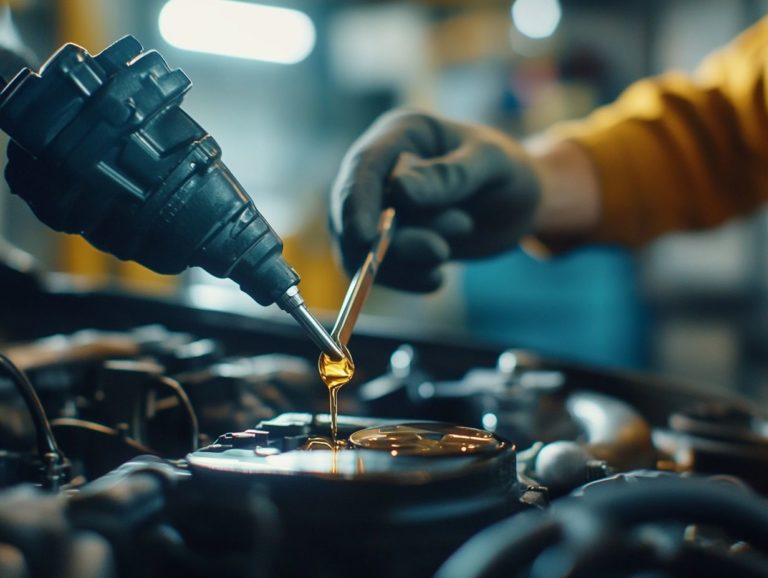How to Know When to Replace Your Tires?
Your tires play a vital role in your vehicle’s overall safety, performance, and fuel efficiency. Recognizing the right moment to replace them can protect you from potential hazards on the road.
This article delves into the key signs of tire wear and offers effective at-home check methods. It emphasizes the importance of timely replacements and clarifies the differences between replacing and repairing tires, helping you select the right ones for your vehicle.
Gain valuable insights that will help ensure your safety on every journey.
Contents
- Key Takeaways:
- Signs that Your Tires Need Replacing
- How to Check Your Tires for Wear
- Importance of Replacing Tires
- When to Replace Tires Based on Mileage
- Replacing Tires vs. Repairing
- Factors to Consider
- Choosing the Best Tires for Your Ride
- Factors to Consider Before Purchasing
- Your Tire Questions Answered
- What are the signs that indicate it’s time to replace my tires?
- What is the recommended tread depth for tires?
- How often should I check my tires for wear and tear?
- Can I replace my tires one at a time, or do I have to replace all four at once?
- How long do tires typically last?
- What are the benefits of replacing my tires on time?
Key Takeaways:

- Regularly check your tires for signs of wear and tear, including tread depth and visible damage, to determine when they need replacement.
- Consider the age of your tires and replace them if they are over 6 years old, even if they appear to have sufficient tread depth.
- Replacing tires is crucial for safety and performance, as worn or damaged tires can increase the risk of accidents and decrease vehicle handling and fuel efficiency.
Signs that Your Tires Need Replacing
Stay ahead of potential risks by recognizing the signs that your tires need replacing. This is vital for maintaining safety and performance, especially in varied driving conditions like those in Phoenix and Glendale, Arizona.
Look out for common indicators such as:
- Uneven tire wear – indicates that your tires may not be lined up correctly.
- Low tread depth – indicates reduced grip on wet surfaces.
- Visible sidewall bulges – can lead to blowouts if not addressed.
- Inadequate tire pressure – negatively affects handling and safety.
Each sign poses risks that could compromise your driving experience and extend your stopping distances. Regular inspections are essential, and having a solid grasp of tire types, like all-season versus performance tires, is key for preventing accidents and maximizing durability.
Tread Wear and Damage
Tread wear and damage are crucial factors that determine whether your tires are safe for the road. They directly impact your vehicle s handling and braking performance.
Understanding different tread wear patterns can offer valuable insights into potential issues. For example, if you notice uneven tire wear, it might point to problems like if your tires aren t lined up correctly or inconsistent tire pressure, both of which can jeopardize your safety.
It’s essential to conduct regular visual inspections. Focus particularly on the sidewalls for any bulges or cracks that could compromise how strong the tire is. Utilize tread wear bars small indicators in your tires that show how much tread is left to gauge whether it s time to consider replacement.
By being proactive with these checks, you can ensure your vehicle remains roadworthy and ready for whatever the journey may bring.
Age of Tires
The age of your tires plays a crucial role in their performance and safety. As tires age, they become more prone to damage, and their durability diminishes.
Understanding tire aging is essential. Even if the tread looks fine, the materials inside can deteriorate over time. This degradation can compromise how strong the tire is, potentially leading to issues like blowouts or loss of traction.
Regular inspections are vital for any vehicle owner. By checking the manufacturer s date, you ensure your tires are in good shape and pinpoint when they might need replacement. Staying alert to tire age promotes safer driving and can ultimately save you from costly accidents caused by unexpected tire failures.
How to Check Your Tires for Wear
Regularly inspecting your tires for wear is crucial for ensuring optimal vehicle safety and performance. You can easily carry out this assessment at home using simple methods, such as the penny test and a few other handy tools.
Act now to ensure your safety!
Simple At-Home Methods

Simple at-home methods for checking tire wear empower you to keep your tires safe and effective. This helps you prevent costly repairs or accidents.
One straightforward technique is the penny test. Insert a Canadian nickel into the tire tread. If the tread covers the round portion of the coin, your tires are likely in good condition. If it doesn t reach that height, it s crucial to replace them immediately!
Using a tread depth gauge is another option. This tool measures how deep the grooves in your tire are. Regularly checking your tire tread not only enhances your safety on the road but also optimizes your vehicle’s performance. Keeping an eye on tread depth can truly make a difference in your stability and control while driving.
Importance of Replacing Tires
The significance of replacing tires cannot be overstated. Worn or damaged tires dramatically impact safety and performance, especially in Arizona’s varied landscapes.
Prioritizing tire maintenance is essential for ensuring your vehicle handles the challenges of the road with confidence and reliability.
Safety and Performance Considerations
When deciding whether to replace your tires, prioritizing safety and performance is essential. These factors greatly influence your driving experience.
Your tires play a key role in how well your vehicle holds the road and how quickly it stops. Worn-out or improperly inflated tires can drastically lengthen stopping distances, jeopardizing the safety of both drivers and passengers.
Well-maintained performance tires are designed to enhance handling and provide superior traction. This leads to improved safety and efficiency in various driving conditions be it rain, snow, or dry pavement. This enhanced grip not only boosts braking performance but also instills greater confidence behind the wheel, ensuring a safer and more enjoyable ride overall.
When to Replace Tires Based on Mileage
Knowing when to replace your tires based on mileage is crucial for effective maintenance and ensuring optimal performance. This is especially important for different types of tires, whether you re using all-season options or high-performing types.
General Guidelines for Different Types of Tires
Learn the basics of when to replace your tires to keep your vehicle safe and running smoothly. Pay attention to the specific mileage recommendations for all-season and performance tires.
All-season tires typically last about 50,000 to 70,000 miles, making them versatile for daily driving in various weather conditions.
In contrast, performance tires, designed for enhanced grip and handling, usually require more frequent replacements typically within 20,000 to 40,000 miles due to their softer rubber compounds. Following these guidelines helps maximize your vehicle’s performance and promote effective tire maintenance, contributing significantly to overall road safety and the longevity of your vehicle.
Replacing Tires vs. Repairing

When you encounter tire damage, it s essential to understand the difference between replacing tires and repairing them. Knowing this can make a huge difference in your vehicle’s safety and the long-term quality of your tires.
Factors to Consider
Several factors warrant your attention when deciding whether to replace or repair tires. Each choice carries distinct implications for safety and vehicle performance.
Among these considerations, the type and extent of damage are paramount. For example, a small puncture in the tread might be a straightforward repair, while sidewall tears or severe wear from age typically demand a full replacement.
Evaluating the tire’s age is also crucial. Older tires may have rubber that has deteriorated, compromising their structural integrity. Warranty claims can also influence your decision, especially if the tire remains under coverage for defects or materials.
Ultimately, you should not overlook the overall quality of the tire, including its brand reputation and performance history. Investing in reliable tires enhances both safety and your driving experience.
Choosing the Best Tires for Your Ride
Selecting the right tires matters. All-season tires work well for everyday driving, while performance tires provide better grip and handling.
Factors to Consider Before Purchasing
Before buying tires, consider a few key factors. Think about tire types, quality, and warranties.
The type of tire affects your experience. All-season tires are versatile, while performance tires offer superior handling.
Quality matters for durability and lifespan. Warranties give you peace of mind and protect your investment.
Your Tire Questions Answered
What are the signs that indicate it’s time to replace my tires?

Common signs include low tread depth, cracks or bulges on the tire, uneven wear, and frequent tire punctures.
What is the recommended tread depth for tires?
The recommended tread depth is at least 2/32 of an inch. You can measure this using a tread depth gauge or by inserting a penny into the tread grooves upside down. If you can see Lincoln’s head, it’s time to replace your tires.
How often should I check my tires for wear and tear?
It’s recommended to check your tire’s condition once a month. This helps catch potential issues early and prevent accidents or tire blowouts.
Can I replace my tires one at a time, or do I have to replace all four at once?
It’s generally recommended to replace all four tires for optimal performance and safety. However, if your tires are relatively new and only one needs to be replaced, you can replace just the damaged tire. Be cautious of mismatched tread wear that can affect handling.
How long do tires typically last?
The lifespan of a tire can vary depending on several factors such as driving habits, road conditions, and tire type. On average, tires last anywhere from 25,000 to 50,000 miles.
What are the benefits of replacing my tires on time?
Replacing your tires on time improves your vehicle’s handling, braking, and overall safety. It can also save you money in the long run by preventing costly repairs or accidents caused by worn-out tires.
Make sure to inspect your tires regularly and consult a professional if you have any concerns!






